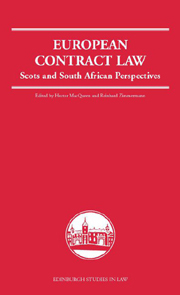Book contents
- Frontmatter
- Contents
- Preface
- List of Contributors
- List of Abbreviations
- 1 Ius Commune and the Principles of European Contract Law: Contemporary Renewal of an Old Idea
- 2 Good Faith
- 3 Offer, Acceptance, and the Moment of Contract Formation
- 4 The Battle of Forms
- 5 Agency
- 6 Threats and Excessive Benefits or Unfair Advantage
- 7 Interpretation
- 8 Third-Party Contracts
- 9 Payment
- 10 Specific Performance and Special Damages
- 11 Termination for Breach of Contract
- 12 Assignment
- 13 Capitalisation of Interest
- Appendix: The Principles of European Contract Law
- List of Cases
- Index
13 - Capitalisation of Interest
Published online by Cambridge University Press: 05 July 2013
- Frontmatter
- Contents
- Preface
- List of Contributors
- List of Abbreviations
- 1 Ius Commune and the Principles of European Contract Law: Contemporary Renewal of an Old Idea
- 2 Good Faith
- 3 Offer, Acceptance, and the Moment of Contract Formation
- 4 The Battle of Forms
- 5 Agency
- 6 Threats and Excessive Benefits or Unfair Advantage
- 7 Interpretation
- 8 Third-Party Contracts
- 9 Payment
- 10 Specific Performance and Special Damages
- 11 Termination for Breach of Contract
- 12 Assignment
- 13 Capitalisation of Interest
- Appendix: The Principles of European Contract Law
- List of Cases
- Index
Summary
INTRODUCTION
Distaste for interest has been pervasive in ethics, religion and law in all of recorded history. The rules against usury are rooted in the idea that interest is by its nature exploitative. If by this reasoning interest is bad, then the taking of interest on interest – that is compound interest or anatocism (the archaic and almost obsolete term for compound interest) – is worse. The word anatocism has a ring about it of something unpleasant.
From an economic and mathematical point of view it does not matter whether compound interest is seen as the adding of accrued interest to a debt as interest or as capital, the effect is the same. In legal terminology, almost as if by verbal sleight of hand, the lawful taking of compound interest becomes capitalisation – the process whereby accrued interest is merged with the principal or capital, so as then to generate further interest on the increased capital amount.
The legal rules on capitalisation indicate circumstances where the taking of interest on interest is tolerated in terms of a statute, agreement or trade usage. Research projects in various countries over the last twenty years or so have indicated that such tolerance has been generally limited and that the law on capitalisation or compound interest has lagged behind economic and commercial realities. In this chapter the focus is on Article 17:101 PECL, which provides for the annual capitalisation of interest for certain types of debt. This provision will be compared with the position in Scotland and South Africa, to assess to what extent it provides a suitable model for reform of the law.
- Type
- Chapter
- Information
- European Contract LawScots and South African Perspectives, pp. 331 - 366Publisher: Edinburgh University PressPrint publication year: 2006



